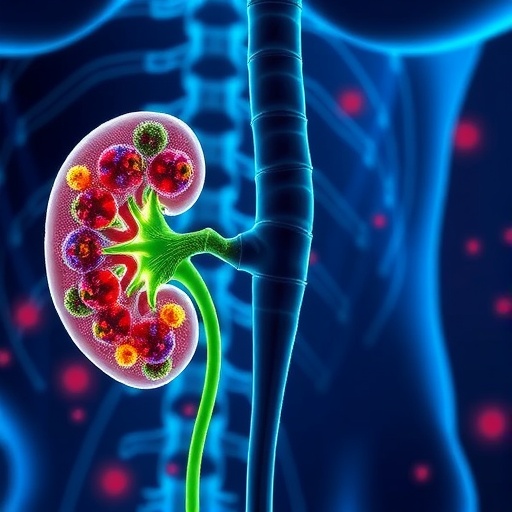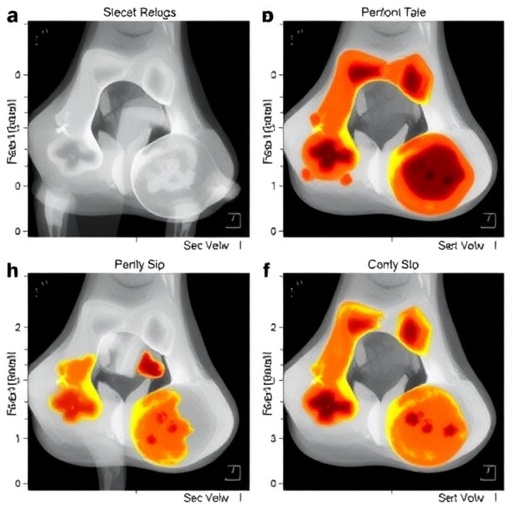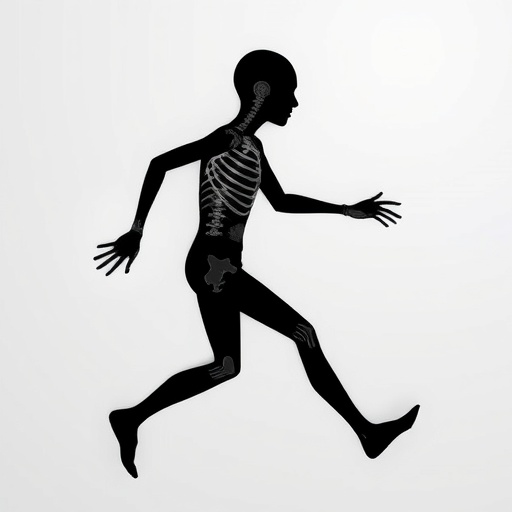In a groundbreaking study published in Genes & Immunity, researchers have unveiled a detailed spatiotemporal transcriptomic landscape that sheds new light on the molecular and cellular mechanisms underpinning ferroptosis and immune cell interactions in ischemia-reperfusion acute kidney injury (AKI). This latest research marks a pivotal advancement in our understanding of the pathophysiology of AKI, a condition that remains a major clinical challenge worldwide due to its high morbidity and mortality rates. The study intricately maps the dynamic gene expression changes occurring over time and space within injured renal tissues, offering unprecedented insights into previously elusive cellular processes.
Ischemia-reperfusion injury, characterized by the transient loss and subsequent restoration of blood supply to the kidneys, triggers a cascade of harmful events that culminate in acute tissue damage. Specifically, this injury precipitates oxidative stress and inflammation, both of which drive progressive kidney dysfunction. The research team focused on ferroptosis, a novel form of regulated cell death distinguished by iron-dependent lipid peroxidation, which has recently emerged as a key player in ischemic damage. By leveraging cutting-edge spatial transcriptomics, the investigators dissected the complex interactions between ferroptosis pathways and immune responses in the injured kidney microenvironment.
Central to the study is the identification of transferrin receptor (TFRC)-linked immune interactions, which appear to mediate critical regulatory networks influencing ferroptotic processes. TFRC, a membrane protein responsible for iron uptake, is known to orchestrate iron homeostasis, but its immunological roles in ischemia-reperfusion injury remain poorly understood. Through comprehensive gene expression analyses, the researchers observed dynamic regulation of TFRC expression across distinct renal compartments, implicating it as a crucial bridge between iron metabolism and immune cell activation. This finding highlights previously unappreciated crosstalk between metabolic and immune pathways in the pathogenesis of AKI.
Temporal mapping revealed the progression of ferroptotic signatures coinciding with specific immune cell infiltration, suggesting coordinated cellular events driving tissue injury. Early stages of reperfusion injury showed elevated markers of oxidative damage and lipid peroxidation, accompanied by recruitment of innate immune cells such as macrophages and neutrophils. As injury progressed, adaptive immune components appeared engaged, signifying a complex immunological milieu evolving over time. These insights could inform future therapeutic strategies aimed at precisely timed interventions to mitigate damage.
The researchers employed state-of-the-art spatial transcriptomic technologies to preserve the spatial context of gene expression within kidney tissues. This approach enabled the resolution of cellular heterogeneity and microanatomical niches, which are often lost in bulk sequencing methods. Such spatially informed transcriptomic data are invaluable for understanding the intricate cellular dialogues in the kidney’s cortex and medulla following ischemic insult. By correlating spatial gene expression patterns with histopathological features, the study elegantly delineates how ferroptosis and immune responses are spatially orchestrated.
Further analysis pinpointed key molecular players and signaling pathways involved in ferroptosis regulation. The team identified upregulated genes associated with lipid metabolism, iron handling, and antioxidant defense mechanisms, indicating a complex balance between pro- and anti-ferroptotic influences. Intriguingly, immune-related genes linked to inflammation and cell recruitment were co-expressed with ferroptotic markers, underscoring the synergistic interplay between metabolic dysfunction and immune activation in AKI pathophysiology.
Importantly, the study’s findings provide a refined understanding of TFRC beyond its classic role in iron transport. TFRC’s heightened expression in immune cells suggests it may modulate immune responses through controlling iron availability, potentially affecting how immune cells contribute to tissue injury and repair. This insight opens exciting avenues for targeted therapies that manipulate TFRC-mediated pathways to attenuate inflammation and ferroptosis simultaneously.
From a clinical perspective, these discoveries could fuel the development of novel biomarkers for early diagnosis and monitoring of ischemia-reperfusion injury. The precise spatial and temporal gene expression profiles distilled from this study may allow clinicians to detect and differentiate stages of kidney injury more accurately, thus improving prognostication and treatment personalization. Furthermore, targeted modulation of ferroptosis and TFRC-related immune interactions has therapeutic potential for limiting AKI severity and enhancing recovery.
The research also contributes broadly to the expanding field of spatial transcriptomics, demonstrating its powerful utility in dissecting complex tissue injuries. By integrating high-resolution transcriptomic data with immunological and metabolic frameworks, the study exemplifies how this technology can accelerate discoveries in translational medicine. It sets a new standard for mapping disease processes with unparalleled molecular detail in their native tissue context.
Beyond the kidney, ferroptosis is gaining recognition as a driver of tissue damage in various diseases, including neurodegeneration and cancer. The mechanistic insights gleaned here regarding iron metabolism and immune crosstalk may be extrapolated to these disorders, potentially catalyzing cross-disciplinary therapeutic innovations. The study thus resonates well beyond nephrology, offering a conceptual blueprint for investigating ferroptosis-linked pathology in other organ systems.
This investigation also highlights the intricacies of immune system involvement in non-traditional contexts, such as iron-centered cell death. The demonstrated link between TFRC and immune cell behavior challenges prevailing views and encourages deeper exploration of iron’s role in immune modulation. Such explorations could redefine our understanding of immune homeostasis and dysregulation in disease.
Overall, the innovative integration of spatiotemporal transcriptomics with focused molecular and immunological analyses provides a multidimensional perspective on ischemia-reperfusion AKI. It navigates the complex terrain of ferroptotic damage intertwined with immune responses, setting the stage for transformative advances in diagnosis, monitoring, and therapy. As AKI continues to burden global health systems, such insightful research brings hope for significantly improving patient outcomes through precision medicine paradigms.
The study heralds a new era where detailed molecular cartographies of injury processes unlock opportunities to thwart cellular demise and modulate detrimental immune triggers in targeted fashion. By illuminating the interactive networks centered on TFRC and ferroptosis, the work paves the way for tailored interventions that could revolutionize clinical management of ischemic kidney injury and related inflammatory conditions. This will undoubtedly inspire a wave of follow-up investigations aimed at translating these molecular insights into effective treatments.
In conclusion, the pioneering spatiotemporal transcriptomic analysis conducted by Wang, Zhu, Lv, and colleagues reshapes our understanding of the interplay between ferroptosis and immune mechanisms in acute kidney injury. It bridges disciplines encompassing cell death biology, immunology, and spatial genomics, marking a seminal contribution that will resonate across biomedical research and clinical practice. As the scientific community builds upon these revelations, the prospect of mitigating kidney damage through fine-tuned control of ferroptosis and immune activity becomes ever more tangible.
Subject of Research: Ferroptosis and immune interactions in ischemia-reperfusion acute kidney injury (AKI)
Article Title: Spatiotemporal transcriptomic insights into ferroptosis and TFRC-linked immune interactions in ischemia-reperfusion acute kidney injury
Article References:
Wang, Y., Zhu, C., Lv, S. et al. Spatiotemporal transcriptomic insights into ferroptosis and TFRC-linked immune interactions in ischemia-reperfusion acute kidney injury. Genes Immun (2025). https://doi.org/10.1038/s41435-025-00364-0
Image Credits: AI Generated
DOI: 15 November 2025
Tags: advancements in kidney disease researchferroptosis in acute kidney injurygene expression changes in kidney injuryimmune cell interactions in kidney damageiron-dependent lipid peroxidation in kidney cellsischemia reperfusion injury mechanismsnovel therapeutic targets for AKIoxidative stress and inflammation in AKIpathophysiology of acute kidney injuryspatial transcriptomics in renal researchtransferrin receptor role in kidney injuryunderstanding kidney microenvironment dynamics






